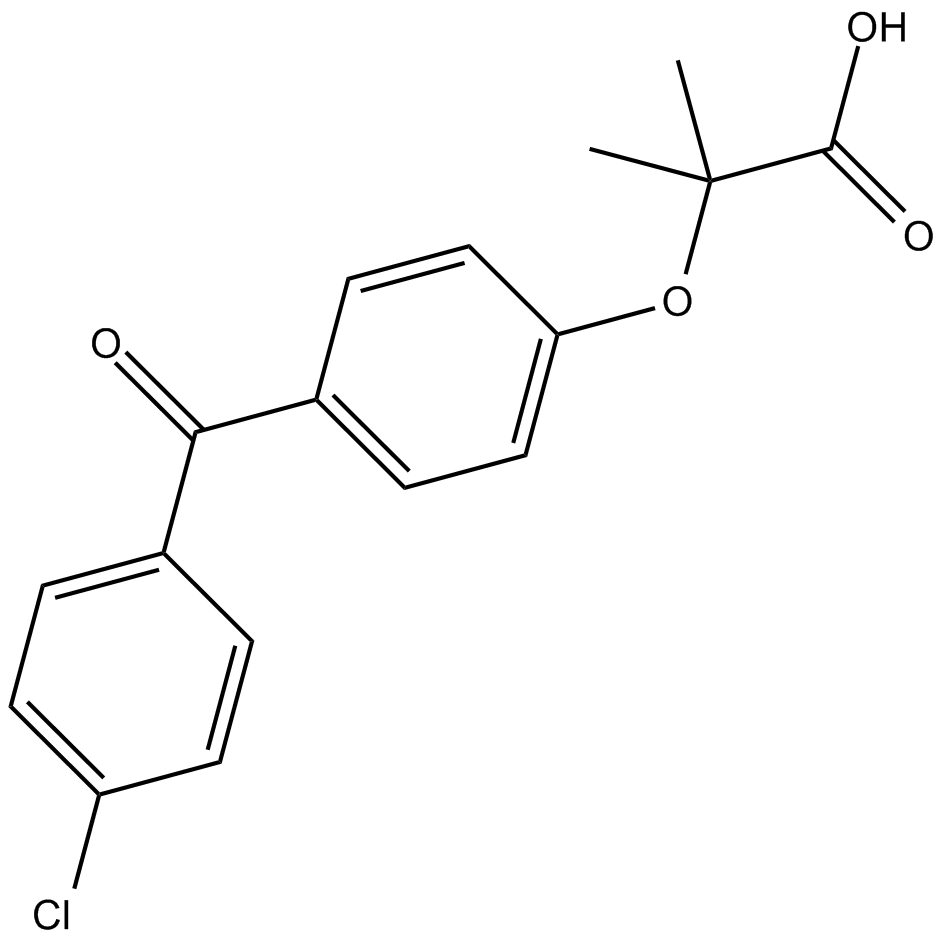Fenofibric acid (Synonyms: FNF Acid, NSC 281318, Procetofenic Acid) |
| Katalog-Nr.GC14584 |
FenofibrinsÄure, ein aktiver Metabolit von Fenofibrat, ist ein PPAR-Aktivator mit EC50-Werten von 22,4 μM, 1,47 μM und 1,06 μM fÜr PPARα, PPARγ bzw. PPARδ; FenofibrinsÄure hemmt auch die COX-2-EnzymaktivitÄt mit einem IC50 von 48 nM.
Products are for research use only. Not for human use. We do not sell to patients.

Cas No.: 42017-89-0
Sample solution is provided at 25 µL, 10mM.
Fenofibric acid, an active metabolite of fenofibrate, is a PPAR activitor, with EC50s of 22.4 µM, 1.47 µM, and 1.06 µM for PPARα, PPARγ and PPARδ, respectively; Fenofibric acid also inhibits COX-2 enzyme activity, with an IC50 of 48 nM.
Fenofibric acid is a PPAR activitor, with EC50s of 22.4 µM, 1.47 µM, and 1.06 µM for PPARα, PPARγ and PPARδ, respectively[1]. Fenofibric acid (10, 25, 50, 75, and 100 nM) dose-dependently inhibits COX-2 enzyme, with IC50 of 48 nM[2]. Fenofibric acid (500 nM) reduces abundance of AOX1 protein in HepG2 cells[3]. Fenofibric acid (100 µM) decreases JNK1/2, c-Jun, and p38 MAPK phosphorylation, and prevents the accumulation of reactive oxygen species, endoplasmic reticulum (ER) stress and disruption of blood retinal barrier (BRB) in response to the combination of high-glucose (HG) and hypoxia in ARPE-19 cells. Fenofibric acid (100 µM) activates IGF-IR/Akt/ERK1/2-mediated survival signaling pathways in ARPE-19 cells under HG conditions and hypoxia[4].
Fenofibric acid (1, 5, 10 mg/kg, p.o.) shows anti-inflammatory activity in Wistar rats with acute inflammation induced by carrageenan[2].
References:
[1]. Dietz M, et al. Comparative molecular profiling of the PPARα/γ activator aleglitazar: PPAR selectivity, activity and interaction with cofactors. ChemMedChem. 2012 Jun;7(6):1101-11.
[2]. Prasad GS, et al. Anti-inflammatory activity of anti-hyperlipidemic drug, fenofibrate, and its phase-I metabolite fenofibric acid: in silico, in vitro, and in vivo studies. Inflammopharmacology. 2017 Dec 13.
[3]. Neumeier M, et al. Aldehyde oxidase 1 is highly abundant in hepatic steatosis and is downregulated by adiponectin and fenofibric acid in hepatocytes in vitro. Biochem Biophys Res Commun. 2006 Nov 24;350(3):731-5. Epub 2006 Sep 27.
[4]. Miranda S, et al. Beneficial effects of fenofibrate in retinal pigment epithelium by the modulation of stress and survival signaling under diabetic conditions. J Cell Physiol. 2012 Jun;227(6):2352-62.
Average Rating: 5 (Based on Reviews and 6 reference(s) in Google Scholar.)
GLPBIO products are for RESEARCH USE ONLY. Please make sure your review or question is research based.
Required fields are marked with *




















